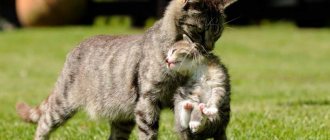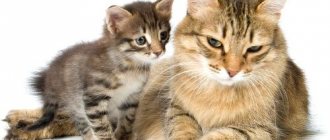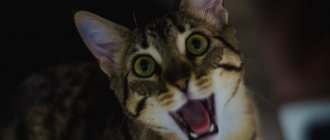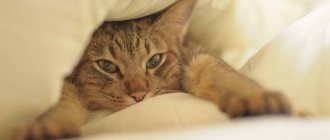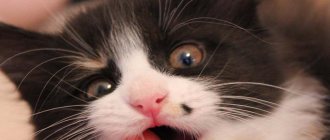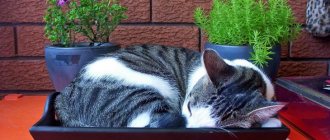Often after lambing, owners witness how a cat carries kittens. There are many reasons for such actions, starting with the owners’ excessive curiosity about furballs, and ending with postpartum eclampsia of the female. To save the lives of the younger generation, you should familiarize yourself with the main provoking factors and methods for eliminating them.
How does a cat carry kittens?
Why does a pet hide kittens?
According to reports from owners of first-born cats, the mother often hides her offspring due to her inexperience. A young cat does not yet know what to do with babies who squeak pitifully. The frightened female begins to drag and hide the kittens.
The owner should properly organize the shelter (prepare a convenient box, calm the cat, protect the household from curiosity).
Another reason for hiding is the illness or poor health of one of the cubs. The owners observe the following picture: the cat drags the weakest kitten around the room, looking for an opportunity to accommodate it in the best possible way. Having found a place that is safe, from the animal’s point of view, the mother brings the others there in her teeth.
How to make a nest for kittens
If a cat behaves restlessly, constantly hides and is found in the most unexpected places, you should think about arranging a house for future kittens. If this process is left to chance, the female may give birth on a pile of bedding or in a clothes closet.
Advice from experienced cat lovers:
- A few days before giving birth, build 3 nests and place them in different, preferably dark, places in the apartment. When the cat chooses one of the proposed options, the rest must be removed.
- To arrange a cat's nest, take a box or basket of appropriate size. It is lined with soft fabric on the outside and inside, and material with a denser texture, such as baby diapers, is placed on the bottom. As an alternative, you can take an exhibition tent equipped with a door. If necessary, it can be closed and prevent children from dragging themselves around.
- In the room where the cat family will be, the optimal temperature should be set - not lower than 28°C. If necessary, use infrared lamps with a power of 250 W. At lower temperatures, babies may catch a cold. If a newborn's body temperature drops to 35°C, he or she develops aspiration pneumonia, which can be fatal.
The birth and care of newborn kittens are dictated by the maternal instinct of the female. You should only interfere with this natural process if absolutely necessary. Any help should be unobtrusive and delicate, since no one can know better than a mother how to take care of babies.
Video - How does a cat carry her kittens?
The article will provide an opportunity to quickly find answers to a number of pressing questions that are directly related to kittens and cats and the relationships between them. It is recommended to pay attention to other articles, as they provide equally useful and relevant information for lovers of four-legged pets.
Why does a cat drag kittens to different places and from place to place around the apartment and onto the bed out of the box, what to do in this case
If a cat drags kittens to another place, it means that her natural instinct to preserve offspring is triggered. She sees a danger for her children, this could be excessive attention from family, an inconvenient place for the offspring (small, hard). Sometimes a cat experiences nervous overexcitation after giving birth, which results in the transfer of kittens. If a cat hides one kitten, it means that it is sick or weak and she protects it from her brothers.
What to do? First, try to find the cause of the animal’s anxiety and think about how to eliminate it. Follow the cat, make her a house in the place she has chosen, or gently but persistently offer her another place. You cannot pull a kitten out of a cat’s teeth, scold or beat it.
If a cat brings a kitten to its owner, this may mean that they need extra food.
How a cat drags kittens by the scruff of the neck
Even the most playful kitten calms down when mom takes him by the scruff of the neck. They become quiet in just a few seconds. It turns out that the kitten instinctively understands that they are going to protect it, and how it can contribute to this.
The cat takes her child by the withers very carefully; she will never harm or injure the kitten. The exception is animals with postpartum depression, which can drag their offspring to death. These cases, fortunately, are very rare.
Hello, Nastya!
Sometimes a cat that has recently given birth, for no apparent reason, begins to drag kittens from the “maternity ward”, carefully equipped by the owners, to a completely, in their opinion, inappropriate place. What is the reason for this behavior of the “young mother”?
In the simplest case, the animal may be worried, and its instinct will force it to hide the babies in a secluded corner. Alternatively, the cat is uncomfortable in the same place - too hot or cold, too light. Maybe we should put the box under the bed? The pet seems to feel safe and comfortable with its family in this place. Perhaps in a couple of days she will calm down and stop moving the babies from place to place.
A difficult case is eclampsia, a disease most often caused by a lack of calcium in the blood.
The best place for kittens
To prevent the cat from dragging the babies around the room after giving birth, you should think about the location of the family in advance. To do this, it is necessary to prepare 3-4 nests a few days before lambing, let the furry mother choose the most suitable one herself. They need to be installed in a quiet room with shade. Places can be placed in the corners of the room to make the cat feel protected. It is advisable that there are no other animals nearby, the room is quiet and calm. Sometimes the best option, especially in apartments with children, is a wardrobe.
In any case, the place where the cat can hide the kittens should be dry, warm, and safe. Only in this case can we hope that it will suit the caring mother, and she will not look for another and drag the cubs.
To build a cat's nest, a cardboard box of the appropriate size is suitable. It can be lined with fabric and baby disposable diapers can be placed on the bottom. An exhibition tent is also perfect. It can be closed, which will prevent kittens from being dragged around at night and accidents to the cubs.
When the cat rolls, it will choose a place for itself from the nests pre-arranged by the owner. After this, fallback options must be removed.
The birth of kittens, feeding, caring for helpless animals, their protection and care are the natural instincts of any domestic cat. It is necessary for a person to interfere with these natural processes only if, for some reason, the cat is not satisfied with external conditions. In this case, the animal needs to be helped unobtrusively and delicately. This will not only reassure the new mother, but will also save the lives of the babies.
There are many reasons why cats eat their kittens. They are based on natural instincts. . As a rule, the female hides her nest from outside animals. But often a cat finds it and destroys the offspring.
Carefully observing the relationship between a cat and kittens, owners often notice that the pet does not show very warm and tender feelings towards its cubs. Reasons why cats bite their kittens.
From it you will learn about the reasons that force mothers to hide kittens, the undesirable consequences of such behavior, and what owners should do in this situation. . Why is a cat skinny, reasons why a cat is not.
If for some reason the nest was not prepared, then the first thing they should do is. The tray should also be located close to the box with the kittens so that the cat can safely go to the toilet without fear of leaving the cubs for a long time.
Kitten nutrition
Something like this might be suitable for a cozy place for a cat and kittens
And then - if she likes it. Something like this might be suitable for a cozy place for a cat and kittens. And then - if she likes it. The ideal place for a cat and her newborn kittens is where there is a warm floor, moderate lighting (preferably dark) and the absence of unnecessary furniture.
Under no circumstances should you forcibly take kittens and drag them to a more suitable place, in your opinion. This can have a negative impact on the psyche of a cat experiencing stress after giving birth. Finally, it is worth recalling that there is no need to interfere with the process of nature - the cat itself knows how to take care of the kittens. Therefore, peace and quiet is the best way to relieve her of such difficult worries about the kids. Of course, the only reason you need to intervene is if the cat is sick and you need to help her.
What to do in such situations?
So that the cat has no reason to worry and remove its offspring from the equipped nest, the owner should take the following measures:
You can prevent this situation by preparing and arranging a box for the expectant mother in advance.
- Prepare in advance a comfortable, safe place where the cat can give birth to babies. Usually a closed cardboard box and a soft, warm bedding are enough for this.
- Protect from other pets. Other cats and dogs should not look into the house. A new mother must be sure that nothing will happen to her babies.
- Maintain a comfortable temperature in the room.
- Keep the litter clean. For convenience, you can line the bottom of the box with disposable diapers, which you can replace with new ones when dirty.
The cat should feel supported by the owner. If an animal is worried and behaves unnaturally, there are good reasons for this and it is important to find out them as soon as possible. If you can’t figure out on your own what the pet is not happy with and why she drags the kittens from place to place, it is better to seek advice from a veterinarian. Sometimes, to determine an accurate diagnosis, a comprehensive diagnostic study will be required, after which adequate treatment will be prescribed.
What should a pet owner do?
In order to prevent a cat from dragging its kittens and avoid unpleasant consequences, the owner needs to do the following:
- Prepare several suitable places for the expectant mother in advance. These should be cozy and comfortable shelters hidden from prying eyes.
- Keep them away from other pets. So, the cat and kittens will feel calm.
- Observe the temperature regime of the room where the cat is located.
- For greater comfort for children, it is advisable to line the box with soft and warm fabric, and cover the bottom with disposable sheets. The basket or box should not be large.
Warmth and safety are the main conditions.
As soon as the cat gives birth, she will choose from the places prepared in advance by the owner.
If the owner did not take care in time and did not prepare a place for the kittens or organized them in the wrong way, he must immediately begin preparing cozy and comfortable shelters. When arranging a space for a pet and her offspring, it is necessary to make sure that she likes this place and satisfies her needs.
Cat owners often observe how their pets drag their cubs after lambing. There are many reasons why a cat takes kittens to another place: from excessive attention of people to babies to postpartum eclampsia. Finding out the true reason for this behavior is necessary to ensure the safety of the offspring.
Read in this article
What are the main reasons for the transfer of kittens?
To understand the reasons for the transfer of kittens, it is important to understand at what point in time the kittens are carried:
- immediately after birth (plus/minus a few days);
- in 3-4 weeks.
If a cat carries kittens immediately after giving birth
The mother cat will most likely try to transfer her kittens during the first few weeks after birth. The kitten's movement may indicate that:
- the cat is nervous, there may be a lot of attention on your part;
- the cat has no experience and does not know what to do with the litter;
- she feels that the nest is unsafe and tries to hide the kittens;
- the nest is in an untidy condition, in other words, simply dirty.
The cat is nervous, perhaps a lot of attention from you
During the first few days after the kittens are born, interaction with the kittens should be kept to a minimum. It will be enough to check the condition of the mother and kittens, and that there is food in the bowl and that her litter tray is clean. If your cat is constantly nervous or agitated, have minimal contact with the cat for the first two weeks. After this time, the situation should return to normal.
It is known that during the first weeks of life, kittens cannot regulate their body temperature.
Therefore, they depend on the warmth of their mother. By the way, if “Murka” often moves her kittens, there is a risk that they may catch a cold.
Maternal aggression towards people and other animals is quite normal behavior in cats. But it will pass as the kittens grow older.
The cat has no experience and does not know what to do with the litter
For the most part, cats treat their kittens very well. However, if this is her first litter, then the situation may be completely different - even eclampsia.
Eclampsia is a critical decrease in the level of total calcium in the blood serum of a pregnant or lactating cat. As a result of calcium metabolism disorders, the amount of calcium in the body becomes below normal. This leads to a very serious, rapidly developing and dangerous condition - milk fever.
In this situation, there is certainly a danger that she may inadvertently harm her kittens.
At one time, we were almost “taken by Kondraty” when our cat began to hiss and rush at the kittens after the first birth.
The cat feels that the nest is unsafe and tries to hide the kittens
Most often, a cat will try to move her kittens on the second or third day after birth.
This is a necessary action in the wild. This way, they avoid predators who might be attracted by the scent of a recent birth.
Cats have a very hard time resisting ingrained instincts!
The nest is in an unkempt state
You must ensure that her nest and bedding are clean. A dirty place is one of the most common reasons why cats want to move their kittens. After all, they can’t wash the bedding themselves!
By the way, you can use regular disposable diapers and change them once a day.
Instincts, character and behavior of cats
Instinct is an inherited quality that encourages the performance of rational actions based on an unconscious impulse. Such automatic signals are controlled by the central nervous system.
The strategy of cat behavior is based on the following instincts:
- self-preservation;
- prolongation of the family;
- territory protection;
- satisfy the feeling of hunger.
Due to the fact that cats are intellectually developed creatures, they have play and communication needs.
The desire to chase a running mouse is inherent in a cat at the genetic level.
In order for the trigger mechanism to work, awakening instincts, an irritating factor is necessary. For example, scratching or rustling sounds are a signal for furry pets to capture a victim.
Any reflex corresponds to a biological purpose and is interconnected with the outside world. Among the most important are hunting, sexual and maternal.
Since, thanks to the food instinct, the animal goes in search of food, it is one of the leading
Scientists combine all the studied instincts into several broad groups.
Table 1. Studied instincts in cats
| Category | Description |
| Ensuring the vitality of the body |
|
| Formative socialization |
|
| Allowing adaptation to the environment |
|
After the birth of kittens, maternal instinct comes to the fore
Animals kept in a limited area lose some of their behavioral patterns. This occurs due to the loss of their original meaning. For example, the hunting instinct undergoes changes in the process of domestication of cats. Running speed, jumping ability, good sense of smell, touch and hearing remain at the proper level, but the desire to catch prey gradually atrophies. The pet gets used to the daily feeding schedule and is not bothered by searching for food on its own.
In domestic cats, territorial and social instincts play an important role, especially maternal instincts. Regardless of the conditions of detention and other components, it does not lose its relevance.
The owner's concern for the pet leads to the extinction of the hunting instinct
Maternal instinct
The behavioral repertoire of a cat that has given birth is based on meticulous care for the offspring.
During pregnancy, in addition to producing the hormone responsible for milk production, the body produces oxytocin. This substance is responsible for the bond between cats and kittens. The mechanism of operation is simple. The smell of the female's amniotic fluid remaining on the babies stimulates recognition of the offspring. Therefore, olfactory signals play a significant role in the first 20 days after birth.
How to tell if a cat is pregnant
Caring for offspring changes with the development of the mental and physical state of children. In its absence, they are stunted in growth. For 3 weeks after giving birth, the female tirelessly looks after the kittens. If they crawl away from the nest, she brings them back. In most cases, kitten dragging is considered normal at this stage. The exception is the restless, repeated shifting of babies from place to place. This is caused by a dangerous postpartum pathology.
Scientists have found that it is safe for a kitten to be kept in a female's teeth. Certain impulses are formed in the animal’s brain that help maintain balance and better orientation in space when carrying offspring. In addition, babies instinctively assume the fetal position and pull their limbs towards their body, providing themselves with additional stability.
When placed in the mother's teeth, the kitten automatically takes on the form of a fetus.
Character traits
In addition to instincts, animals are governed by character. Along with reflexes, cats have a collection of well-developed individual behavioral strategies. The formation of the latter depends on the situation surrounding the animal. Depending on the personality traits of the female, the postpartum behavioral pattern may change.
The human cat loves to make a nest in the owner's bed
Researchers identify 5 types of cat personalities.
Table 2. Varieties of cat characters
| Type | Characteristic |
| Cat-man | Very sociable animals that need constant care. They are attached to the owner and do not skimp on expressions of feelings. They see themselves as family members and try to take part in the daily life of their owners. |
| Hunter cat | Has pronounced hunting instincts. Constantly chases birds, mice and enthusiastically runs after toys. Doesn't feel well in confined spaces. Needs walking. |
| cat-cat | He prefers spending time with representatives of the cat family to communicating with people. He likes to live in a couple and does not get bored in an empty apartment. Pets of this type can often be found rubbing noses with their own kind. |
| Grumpy cat | The most aggressive and independent type. He feels like the owner of the territory and does not allow encroachments on his property. Doesn't like to play with people, rejects affection. |
| Curious cat | Constantly absorbed in exploring the surrounding space, using the senses of smell and touch. Perceives new people positively and strives to be outside the home. An inquisitive mind often leads to a loss of control over a situation. |
Most cats have the ability to learn from their own mistakes and avoid repeating negative experiences. There is a theory that pets play out several possible options in their minds before performing any action.
Cats belong to the category of intellectually developed animals
Undesirable consequences
There are certain dangers in having a cat constantly traveling around the apartment with small kittens. When dragging the cubs, they may be injured. A cat can drop them from a height, and at this age a fall can be fatal.
When carrying the baby, the mother squeezes it quite tightly with her teeth, and when the kitten is already quite old, she drags it with drag. This situation can result in injury or death. Under no circumstances should you take kittens away from your pet while she is carrying them. The animal instinctively clenches its teeth tighter and can harm the baby.
Constantly carrying babies, the cat often forgets them. Without food and warmth, a helpless kitten may die.
What should owners do?
What to do if a cat carries kittens? This is the question that puzzles owners as they watch their pet looking for a new place for her offspring and transferring the cubs there.
First of all, it is necessary to understand the reasons that prompt the animal to such actions. Kittens should not be selected or placed in a place chosen by the owner. It is necessary to trace where the cat has found a new place and help build her a nest.
The animal should be denied access to places where the arrangement of a new place would be unsafe (balcony, space under the bathroom, etc.). Under no circumstances should you scold or punish a caring mother.
The animal obeys natural instincts and takes care of its offspring as nature dictates.
Owners sometimes misinterpret why a cat brings kittens to bed. You should not think that a caring mother entrusts her offspring to household members or brags about her kittens. Such feelings are alien to animals. The reason for the behavior is the search for a more favorable place for their offspring. And the master’s bed can be chosen as this place (warm, dry, clean).
There is also nothing touching about an animal dragging its cubs to a person. The reason why a cat brings kittens to the owner is, as a rule, a lack of food. The pet perceives humans as a source of food resources. As babies grow older, milk is no longer enough and they need solid food. This is why a cat brings its cubs to humans as a source of food.
What should an owner do when a cat carries kittens?
Even during the period of bearing offspring, the owner must ensure that the expectant mother is satisfied with the “maternity hospital” he has equipped. It would be better if it was a spacious box with low sides. It's called a nest. The place should be warm, without drafts, not too lit, quiet. The box should be ready about a week before the birth so that the cat can sniff everything and adapt to it. If a pregnant woman spends several nights in a nest prepared by the owner, this reduces the risk of subsequent dragging of offspring by the cat.
Never take kittens from their mother by force! Such actions can negatively affect the pet’s psyche. After all, after giving birth, she experiences stress. Just block access to places where the mother should not go with her kittens, for example, to the closet. If a nursing pet has chosen a secluded corner under the radiator, then help her make it more comfortable: put some bedding and block it with something.
If you suspect eclampsia, be sure to call a veterinarian at home. He will inject the cat with calcium gluconate, a sedative, and she will soon calm down.
Like any new mother, a cat who has given birth undoubtedly has more worries. Animals have a genetic instinct to care for their offspring, and even a young pet knows that her babies need warmth, food and protection. However, having no experience, she begins to drag kittens from one place to another. What causes this reaction?
False pregnancy in cats
False pregnancy is a pathological condition of an animal in which it believes itself to be pregnant, but is not. In this case, all the signs of pregnancy may appear: nipples swell, colostrum is released, behavior changes, the cat may begin to build a nest.
This happens under the influence of the production of sex hormones. In advanced cases, an increased amount of colostrum can affect, for example, the formation of mastitis.
Any such condition is stressful for the animal and can ultimately lead to many pathologies. And if before this you did not want to sterilize your cat, the manifestations of a false pregnancy should make you think and take your cat for sterilization. After all, in the future you can get diseases such as pyometra, ovarianitis, endometritis and breast cancer with the highest percentage.
Early neutering can prevent all of these pathologies if the cat never gives birth. Remember that every time a cat goes into heat, it experiences severe stress, which, in addition to wasting hormone production, triggers other pathological processes.
In case of false pregnancy, it is important to consult a veterinarian for advice - he will tell you what medications should be given to reduce the production of colostrum, and prescribe additional treatment, if necessary. On your part, you need to limit your cat's stress and reduce fluid intake.
“It would be good to try to distract the cat from her thoughts about pregnancy, for example, to play with her more often,” advises veterinarian Marina Mikheenko .
By the way, there is an opinion among people that a cat should be allowed to become pregnant and give birth once, so that it can bear offspring and be immediately sterilized. In fact, mating a cat before sterilization is not contraindicated - this can affect both the health and psyche of the animal. The most favorable age for sterilizing a cat is after puberty, which occurs at 10 months (2).
Possible risks
Transporting still fragile babies is unsafe, and in this case various tragic accidents are possible:
- Jumping over high obstacles or climbing to heights, a cat can drop a tiny baby and it will be injured.
- A cat sometimes clenches its teeth too tightly, for fear of dropping its load, which harms the kitten’s skin.
- When choosing a better place, the cat can take the kids to different places and even forget where each “cat child” is. This is especially dangerous for newborn babies.
- A place carefully chosen by mommy may be completely unsafe.
Naturally, no one is immune from tragic accidents, but owners should listen to the opinion of the pet. Even before giving birth, you can take a closer look at which place the “lady in labor” has chosen, and, if possible, install the box there. And most importantly, you cannot drag kittens if they are not in danger, as this will negatively affect the mental state of the pet who gave birth.
What can happen when dragging babies
If a cat constantly drags babies in her teeth, looking for a more reliable place for a nest, the following dangers await the kittens:
- During the transfer process, the kitten may fall, damage limbs, and receive serious injuries.
- While dragging, the cat may damage its withers by biting too hard.
- While hiding the kitten, a young mother may forget where the next hiding place is. A weakened, sick baby will die without maternal care.
Why does a cat carry kittens?
The cat is not happy with the place
One of the reasons why a cat begins to drag her babies from place to place is that the young mother is not satisfied with the place chosen by the owner (“nest”). A huge number of external factors (uncomfortable temperature, bright lighting, drafts, dampness, close proximity to other animals or family members) can provoke a cat to move kittens to another place. The arrangement of the place can also play a role: the bedding should be clean and the room should be moderately spacious; a room that is too open with a large area may seem threatening and unprotected to the mother.
The cat's inexperience in motherhood
For a cat, the appearance of the first offspring is always a very exciting and stressful moment, which can cause an ambiguous reaction in the animal. The cat does not understand why the little kittens squeak, and, trying to calm them down, begins to move the cubs from place to place. The animal should be given time to get used to the new role.
Eclampsia
Eclampsia is a condition in which the level of calcium in an animal’s body drops sharply, which is accompanied by various disorders of the nervous system. The cat begins to have convulsions and tremors, and there may be increased salivation. Attacks occur both during pregnancy and within a month after childbirth. During an attack, the cat becomes irritable and nervous and begins to drag the kittens. This condition is very dangerous; it is strictly forbidden to assist the animal yourself. When the first symptoms appear, immediately show the animal to a specialist.
Breed specifics
Breed specifics also play a role in the behavior of the cat's mother. There are breeds that have an innate instinct to protect their offspring from predatory animals, expressed in excessive guardianship over the offspring. For example, representatives of the Bengal and Singaporean breeds constantly move their brood from place to place. They do this in order to throw predators off the scent and thereby protect their offspring.
How to determine pregnancy
Visually, a cat’s pregnancy can be suspected with an increase in the abdomen and appetite. It is imperative to see a doctor, because there are a number of pathologies that can also manifest themselves. And for further diagnosis, an ultrasound of the abdominal cavity will be required (1). Pregnancy can also be seen on x-rays.
1st – 3rd week of pregnancy in a cat
In the early stages it is very difficult to determine. Only at the beginning of the 3rd week is it possible to see something on an ultrasound, but the cat itself does not show any external signs of pregnancy. Therefore, you will be surprised by the middle of the term, when the cat begins to show obvious signs of motherhood.
4 – 6 weeks of pregnancy in a cat
Only at the beginning of this period does the cat’s nipples begin to change color and they swell.
Also, some cat mothers experience attacks of morning sickness during this period (just like in humans!).
Even during this period of pregnancy, the cat begins to gain weight, she becomes more affectionate and playful, and begins to demand more attention from her owners.
At week 5, the cat’s tummy enlarges and becomes denser.
7 – 9 weeks of pregnancy in a cat
At week 7, you can feel the kittens moving if you lightly put your hand on their tummy.
Don’t be afraid to touch and stroke a pregnant cat, because during such a period the cat really needs care and affection, and a person you can trust. And, of course, when kittens are already obvious in the stomach, your cat certainly cannot hide the pregnancy from you.
If you have a purebred cat and you really need to know about the onset of her pregnancy, the sooner the better, then already 2 weeks after the expected pregnancy occurs, you can take your cat for an ultrasound and the ultrasound will show whether there is a pregnancy.
Types of “safe” meat for cats
More than 80% of a cat's daily diet is meat. But, before feeding your mustachioed pet this product, you need to figure out which types of meat will be beneficial for the cat’s health and which types of this product can cause serious harm to the body.
First of all, you should focus on the following rules:
- the meat must be fresh;
- low-fat;
- without small and dangerous bones;
- no unpleasant odor.
You need to feed your cat high-quality meat, and not waste product that is not useful on the human table. From time to time, your pet can be pampered with offal and cartilage, always fresh and low-fat (no more than 200g per week).
To feed your cat, you can buy chicken, quail, lean lamb, beef, rabbit, turkey, horse, goat and beef.
Pork, duck, goose and fatty lamb are prohibited.
Now let's figure out in what form meat can be served to a domestic cat.
Grilled meat
Fried product is strictly prohibited for feeding domestic cats. After eating such meat, the animal may experience serious problems with the liver, stomach and other organs of the digestive tract. All this will lead to a lot of unpleasant health problems for the pet and will significantly shorten its lifespan.
Cooked meat
This meat can be given to a cat. It contains many nutrients that are beneficial for her body. The main thing is to cook the meat correctly: boil it in low-fat broth without salt and other spices.
And one more rule: you cannot give raw and cooked meat at the same time.
To digest these foods, the body will need to produce different enzymes, which will negatively affect the digestion process. This may manifest itself as vomiting, stool disturbances and other unfavorable symptoms.
Smoked meat
Smoked meat is very dangerous for the body of a small predator. It is unacceptable to feed your pet such a harmful product!
Raw meat
Raw meat is a natural food for domestic carnivores. In their natural environment, cats always feed on prey consisting of small rodents and birds. It’s clear that they consume their catch raw, without cooking.
To create a complete diet for a mustachioed pet, experts recommend combining meat with other healthy foods. For example, you can serve it with vegetable puree and olive oil. Or prepare a delicious soup from low-fat broth with herbs, butter and pieces of meat.
- fresh meat should be cut into pieces, distributed into bags in small quantities for one feeding and sent to the freezer for freezing;
- Meat should be frozen for 3-4 days or more;
- extreme cold destroys helminth eggs, which makes the meat product absolutely safe to feed cats;
- Before serving, the meat can be slightly warmed in the microwave or poured boiling water over it;
- It is better to defrost the product in a plate; after defrosting, juice from the meat will remain in it, which your furry friend will also happily sip on;
- Sometimes you can pamper your cat with raw minced meat, prepared yourself from fresh lean meat, without salt and spices.
How to diversify your cat's diet
You cannot feed your cat only meat and meat products. It is very useful to supplement his diet with a variety of cereals (rolled oats, buckwheat, rice, millet). You need to boil porridge in water, although you can use broth from lean meat. Experts recommend adding a little natural vegetable oil to this mixture, this improves the functioning of the animal’s intestines.
Low-fat fermented milk products are also beneficial for domestic cats - yogurt without additives, kefir or sour cream with a fat content of no more than 9%. Contrary to popular belief, milk is absolutely not healthy for cats, and sometimes even harms digestion.
For your pet’s well-being, it is better not to mix meat and dairy products, for example, give porridge with meat and vegetables at lunch, and a bowl of low-fat yogurt or yogurt in the evening.
Cats love domestic eggs, but they should not be given in large quantities either; excess protein can lead to health problems. A raw quail egg can be offered to the cat as a whole, but only the yolk can be given from a boiled chicken egg.
Is it possible to give raw meat to a cat, and what should it be combined with? Vegetables are great. Your pet's diet can be quite varied. If taught from an early age, the cat will eat boiled vegetables (beets, carrots, cauliflower, zucchini) well. They are mixed with meat or boiled fish.
However, there are quite serious restrictions on mixing feed and natural nutrition.
What may not suit a cat?
Before considering the issue of properly arranging a place for a pregnant cat, it is worth considering the situations when she begins to move the babies and the possible reasons for this behavior:
- The cat is unhappy with the space provided to her. It can be inconvenient and not very safe due to incorrect temperature conditions - the place should not be too hot or too cold. It is also advisable that the box or basket is hidden from direct sunlight. In addition, cats are not inclined to show off their babies early, and a crowded place will also not meet her ideas of safety.
- The reason is the cat's inexperience. Yes, despite her innate instincts, sometimes a new mother does not understand why her babies begin to squeak, and tries to solve this problem by dragging them.
- Eclampsia. A serious illness during which blood pressure rises to a critical level in pregnant and postpartum individuals. The disease can develop for various reasons: due to a lack or excess of calcium in the body, due to poor or poor quality nutrition, due to impaired metabolism. The disease is accompanied by a number of symptoms - nervousness, increased aggression, difficulty breathing. Also, a cat often tirelessly carries kittens and cannot decide on a place. If the owner detects similar behavior in his pet, you should not wait for her condition to worsen, but should immediately contact a veterinarian. Otherwise, there is a risk of death.
- Specific breed characteristics. Representatives of some breeds have a very strong protective instinct, which is why they behave in such a way as to protect their kittens from possible predators. For example, Bengal cats tend to search for secluded places and can change the location of their offspring in order to throw predators off the scent.
Reason for changing registration
There are pets who are overly concerned about their children. They move away a little from giving birth and begin to constantly drag their offspring, finding new habitats every day. Before you find out what the owner should do in such cases, it is worth familiarizing yourself with the reasons for this behavior of the mother:
- The mother is not satisfied with the place chosen by the owners. It may be too hot (the box is under the radiator) or, conversely, very cold; insufficiently protected; too crowded (for example, this is the kitchen, where there are always a lot of people). Also, an area of the house that is too bright may not suit the mother cat. In the latter case, she will drag her offspring into the closet, where it is darker.
- Mom's inexperience. We are talking about first-born cats. They still don’t understand why their babies squeak. Not knowing what to do, such mothers begin to drag their kittens to other places.
- Eclampsia. This is the most serious and dangerous reason for such actions by a new mother. The disease can occur within a month after birth. Its causes are a deficiency or excess of calcium in the body, metabolic disorders or poor nutrition during pregnancy. Eclampsia in females is manifested by nervousness, which turns into aggressiveness, and heavy breathing. A mother with this disease will constantly move her babies to other places. She can bite them. If you suspect eclampsia, it is important to immediately seek help from a cat doctor, otherwise the cat may even die.
- Breed specificity. Representatives of some breeds have a well-developed protective instinct. It manifests itself precisely in excessive guardianship over the offspring, in attempts to drag them into dark places inaccessible to the owners. This is what Singaporeans and Bengal cats do. In this way, they seem to throw predators off the scent and protect the cubs.
If a mother constantly drags her very young kittens around, then such actions can have serious consequences for them. For example, jumping from a height, jumping over the high side of a box, a mother can drop her baby. By holding a child tightly by the withers, a cat can injure him. That is why it is strictly forbidden to forcibly snatch kittens from their mother’s mouth. It also happens that a cat drags each cub to different places and forgets where exactly she hid it. This way the baby can die, especially if he is still blind.
